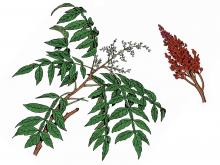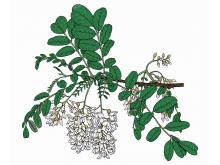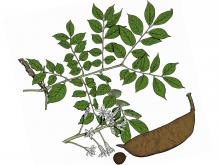Trees, Shrubs and Woody Vines
Media

Species Types
Scientific Name
Juglans nigra
Description
Easily Missouri’s most valuable tree, the black walnut provides the finest wood in the world, as well as delicious nuts. Both are in high demand and thus form an important part of Missouri’s economy.
Media

Species Types
Scientific Name
Rhus glabra
Description
Colonies of smooth sumac are most noticeable in early autumn, because the leaves turn brilliant red! You can make drinks and jellies from the clusters of fuzzy red berries.
Media

Species Types
Scientific Name
Parthenocissus quinquefolia
Description
Occasionally confused with poison ivy, Virginia creeper is easily identified by simply noticing that most of its leaflets are in fives, instead of threes. This common native vine is useful in landscaping.
Media

Species Types
Scientific Name
Rhus copallinum
Description
Winged sumac is most common south of the Missouri River. The "wings" in the name refer to the narrow, flattened leafy structures running along the central stems of the compound leaves.
Media

Species Types
Scientific Name
Rhus spp.
Description
Sumacs are shrubs or small trees that often form colonies from their creeping, branched roots. The foliage usually turns brilliant shades of red in early autumn. The clusters of berrylike fruits are red.
Media

Species Types
Scientific Name
Robinia pseudoacacia
Description
Black locust, a member of the bean family, is easy to appreciate in May and June, when its showy white clusters of flowers perfume the breeze with their sweet smell. Bees like the flowers, too.
Media

Species Types
Scientific Name
Gymnocladus dioicus
Description
There’s no mistaking Kentucky coffee tree when its large, tough seedpods are hanging from its limbs or dropping to the ground below. Unpopular as food with today’s wildlife, these seedpods might have fed mastodons and other large, extinct North American mammals.
Media

Species Types
Scientific Name
Toxicodendron radicans
Description
Poison ivy is a toxic plant that contains an oil in all its parts that, if you come into contact with it, can cause an intense skin reaction. Learn to recognize it, and sidestep it on your outings.
Media

Species Types
Scientific Name
Sambucus canadensis
Description
Common elderberry is a colony-forming shrub with opposite compound leaves. Its large, flattened clusters of small white flowers produce purple or black berrylike fruits.
Media

Species Types
Scientific Name
Rosa multiflora
Description
Starting more than a century ago, this nonnative rose was planted across America — for many good reasons — but multiflora rose has proven to be invasive, and now the goal is to stop its spread.
See Also
About Trees, Shrubs and Woody Vines in Missouri
There are no sharp dividing lines between trees, shrubs, and woody vines, or even between woody and nonwoody plants. “Wood” is a type of tissue made of cellulose and lignin that many plants develop as they mature — whether they are “woody” or not. Trees are woody plants over 13 feet tall with a single trunk. Shrubs are less than 13 feet tall, with multiple stems. Vines require support or else sprawl over the ground.





















